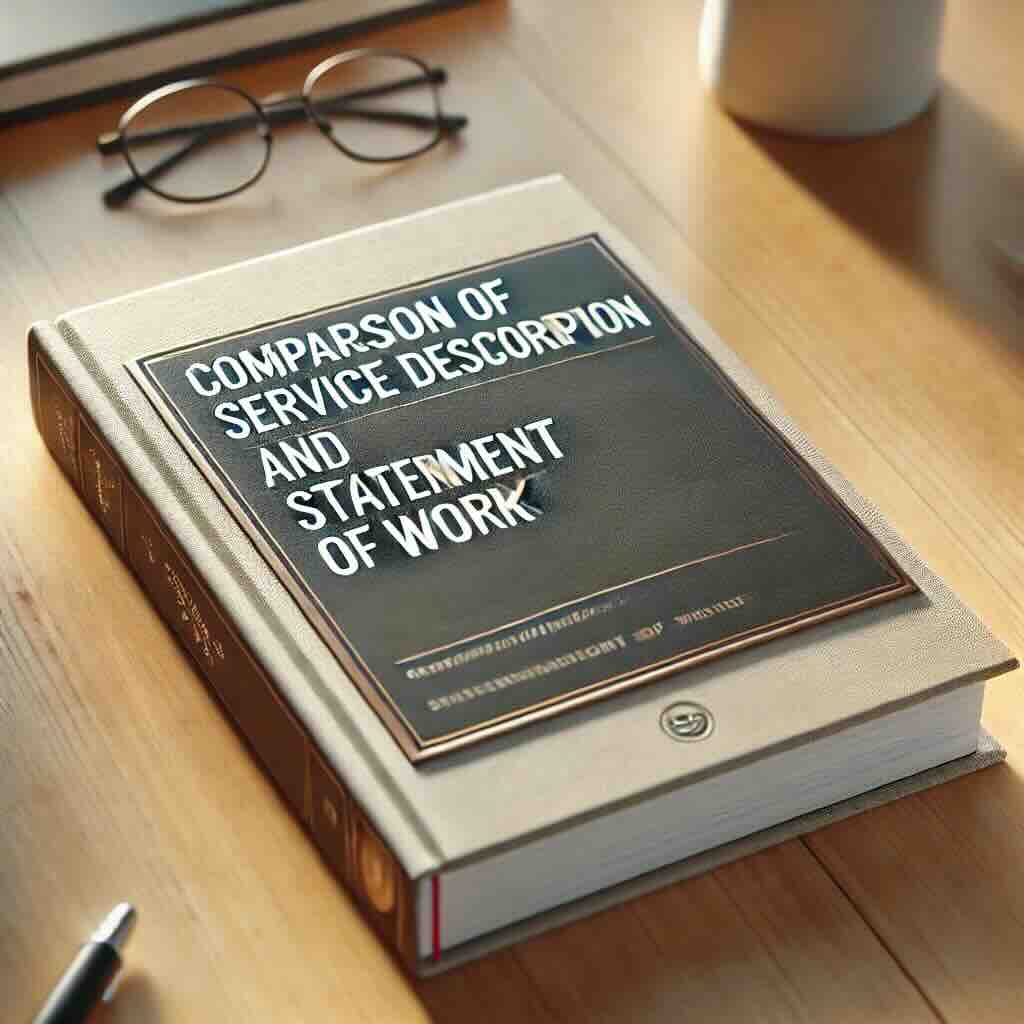When it comes to defining the scope of work for a project or service, two important documents are often used: Service Description and Statement of Work (SOW). While they share some similarities, they also have some distinct differences. In this blog post, we will explore the similarities and differences between Service Description and Statement of Work.
Content…
Statement of Work (SOW) and Service Description, examples
Statement of Work (SOW)
A Statement of Work is a detailed document that outlines the specific tasks, deliverables, timelines, and expectations for a project or service. It is typically used in more complex projects where clear, precise requirements are needed.
When to Use a Statement of Work (SOW):
Complex Projects with Defined Deliverables:
- Example: An organization is outsourcing the development of a custom software solution. The SOW outlines each phase of the software development lifecycle, including requirements gathering, design, coding, testing, and deployment. Each phase has specific milestones, timelines, and expectations that must be met.
- Why SOW: The SOW ensures that all stakeholders are aligned on the scope, deadlines, and deliverables for each phase of the project, minimizing ambiguity.
Outsourced Engineering or Construction Projects:
- Example: A company is hiring a contractor to build a new manufacturing plant. The SOW defines the scope of construction, including materials to be used, timelines for each construction phase, quality control standards, and final inspection requirements.
- Why SOW: The SOW is critical to ensure that the construction project adheres to specific standards, timelines, and legal compliance. It minimizes the risk of scope creep or miscommunication.
Consulting Projects with Milestones:
- Example: A business hires a consulting firm to implement a new enterprise resource planning (ERP) system. The SOW includes a detailed breakdown of the phases (e.g., system assessment, configuration, training), along with deliverables and deadlines.
- Why SOW: The SOW provides clarity on what the consulting firm will deliver at each stage and ensures accountability for achieving measurable outcomes.
Creative or Design Projects with Clear Outputs:
- Example: A marketing agency is hired to create a series of brand videos. The SOW outlines specific deliverables such as video concepts, scripts, storyboards, filming schedules, and editing timelines.
- Why SOW: The SOW provides the client with confidence that the agency will meet their creative expectations while adhering to specific deadlines and quality standards.
Service Description
A Service Description is a high-level document that outlines the scope of services provided, typically in a more standard, ongoing, or operational context. It focuses on the types of services offered rather than specific, one-time deliverables.
When to Use a Service Description:
Ongoing Maintenance or Support Services:
- Example: An IT service provider offers ongoing technical support for a company’s IT infrastructure. The Service Description outlines what types of support are provided (e.g., network monitoring, helpdesk services, hardware maintenance), response times, and service hours.
- Why Service Description: For routine services, the company doesn’t need detailed project-level breakdowns but instead needs a clear understanding of the scope of support and service levels.
Managed Services Contracts:
- Example: A business outsources its HR services to a third-party provider. The Service Description includes an overview of the services offered, such as payroll management, recruitment, employee onboarding, and compliance reporting.
- Why Service Description: Since these services are ongoing and standard, the Service Description provides a sufficient outline of what the provider will deliver without the need for detailed project milestones.
Utility or Subscription-Based Services:
- Example: A company subscribes to a cloud storage provider. The Service Description includes storage capacity, data transfer limits, uptime guarantees, and customer support availability.
- Why Service Description: These services are typically operational and continuous, and the focus is on defining service features, performance metrics, and customer obligations rather than detailed deliverables.
General Outsourcing of Non-Core Functions:
- Example: A company outsources its facility cleaning services. The Service Description outlines the frequency of cleaning, the areas to be cleaned, and the service quality expectations (e.g., sanitizing restrooms, emptying trash).
- Why Service Description: The focus is on the scope of regular cleaning tasks and quality standards rather than one-off deliverables or projects, making a Service Description more appropriate than a detailed SOW.
SaaS (Software as a Service) Contracts:
- Example: A business purchases a subscription to accounting software. The Service Description outlines the features included in the software, support levels, software updates, and data backup services.
- Why Service Description: Since the service is ongoing and the features are standardized, a Service Description provides clarity on what is included in the subscription without needing detailed project steps.
Similarities between Service Description and Statement of Work
It’s important to understand the similarities between Service Description and Statement of Work (SOW), as both play vital roles in defining and managing the scope of a project or service engagement. Here’s an in-depth look at their shared attributes:
Scope Definition
- Service Description:
- Typically provides a high-level overview of the services being offered, outlining the general nature of the work to be performed.
- Helps to set clear boundaries around the types of services or deliverables expected, giving a concise snapshot of what the engagement will cover.
- Statement of Work:
- Offers a more detailed outline of the scope, specifying individual tasks, timelines, and dependencies for project execution.
- Breaks down the work into specific activities, deliverables, and timelines, providing granular detail for project execution.
Setting Expectations Service Description and Statement of Work
- Service Description:
- Establishes a common understanding of the basic service parameters, such as the general type of support, service levels, or frequency of delivery.
- Aids in aligning both parties’ expectations about what is included in the service and what is not.
- Statement of Work:
- Sets expectations in much greater detail, outlining each stage of the work, performance metrics, and measurable success criteria.
- Details the responsibilities of both parties, ensuring a shared understanding of expectations.
Accountability Service Description and Statement of Work
- Service Description:
- Identifies the parties responsible for delivering the defined services, allowing both the provider and client to monitor service fulfillment.
- Often includes the general performance metrics or service level agreements (SLAs) that will be used to measure and maintain quality.
- Statement of Work:
- Assigns accountability at a task level, specifying deadlines, performance standards, and who is responsible for each deliverable.
- Clearly defines the processes for issue resolution and escalation, creating transparency and reducing the risk of misunderstandings.
Specific Requirements Service Description and Statement of Work
- Service Description:
- May include specific requirements like regulatory compliance, technical standards, or quality benchmarks that services must meet.
- Statement of Work:
- Elaborates on specific requirements in greater detail, often including technical specifications, acceptance criteria, and milestones that must be achieved.
Differences between Service Description and Statement of Work
- Focus:
- Service Description: Focuses on outlining the services to be provided at a high level, specifying the type of service, its scope, service levels, and general requirements. It presents an overview that helps clarify the nature of the service without delving deeply into specific tasks.
- Statement of Work (SOW): Provides an in-depth understanding of the work involved, breaking down the project into specific tasks, deliverables, and timelines. The SOW outlines what must be done, when, and by whom, offering a comprehensive and detailed view of project execution.
- Detail:
- Service Description: Offers a broad overview of the services to be delivered but tends to lack granularity. It defines the general expectations and performance metrics without getting into the nuances of individual tasks and responsibilities.
- Statement of Work (SOW): Highly detailed and specific, a SOW provides clear instructions regarding each stage of the work, including deliverables, timelines, milestones, and responsibilities. It is designed to ensure every aspect of the service or project is thoroughly understood and documented.
- Audience:
- Service Description: Geared towards a broader audience, such as potential customers, internal stakeholders, or external partners. It serves as a tool for communicating the general scope and value of services in a clear and concise manner.
- Statement of Work (SOW): Tailored to a more specific audience, usually those directly involved in executing or managing the project. It provides the project team, contractors, or vendors with comprehensive instructions and expectations, ensuring everyone is aligned on the project’s objectives and execution.
- Legal Implications:
- Service Description: Typically functions as a preliminary or supporting document to establish the nature of the services and initial expectations. While it might form part of a contract, it does not hold significant legal weight by itself.
- Statement of Work (SOW): Often carries legal implications, as it is generally incorporated into the formal agreement between the service provider and the client. It specifies the contractual obligations of both parties, including deliverables, performance standards, and timelines, making it legally enforceable in disputes.
Summary Service Description and Statement of Work.
- Statement of Work (SOW) is ideal for complex, project-based contracts where the buyer requires detailed milestones, clear deliverables, and precise timelines.
- Service Description is more suited for ongoing, operational, or standardized services where the focus is on defining the scope of the service, response times, and service levels without requiring project-specific details.
Understanding the differences and when to use each can help procurement professionals ensure they are aligning the right contract type with the nature of the services being provided, which in turn leads to better outcomes and smoother vendor management.
Both a Service Description and a Statement of Work are critical for defining the scope and expectations of a service engagement. While a Service Description provides a high-level overview of the services and their general parameters, the Statement of Work dives deeper into the specifics of how these services will be delivered and measured. They complement each other by ensuring that expectations are managed clearly, accountability is established, and both parties understand their roles and responsibilities within the project or service framework.

The Service Description and Statement of Work both play critical roles in defining the scope of services or projects. The Service Description provides a high-level overview, while the Statement of Work dives into the specific details necessary for project execution. Understanding these differences is essential for ensuring clarity in communication, setting expectations appropriately, and effectively managing projects and services. The Service Description serves as a general guide, whereas the SOW is a more comprehensive roadmap that binds all parties to the successful completion of the work.
Learn more about Service Description in the blogpost RFQ and Service description are a strong pair. Learn more about SoW in the blogpost Content in a Statement of Work.
Learn more about writing a RFQ in the course RFQ template. When developing a RFQ, certain information is required in order for the suppliers to provide a strong and relevant quotation and give the buyer the possibility to build a competitive supply chain. But depending on the market, and the sourcing tactics, consideration needs to be made in order to create the desired negotiation position and, at the end, the desired relation to the selected supplier.
Deployed’s Services Library provides a comprehensive breakdown of consulting services across various categories, such as Financial, HR, Marketing, Operations, Real Estate, Supply Chain, and more. Each service includes clear descriptions of deliverables, activities, and acceptance criteria, supporting organizations in optimizing processes like inventory management, workplace design, sustainability strategies, and digital marketing. These services help businesses enhance performance, efficiency, and compliance across key operational areas. For more details, visit the full library here.
Note: Illustration to the blogpost “Service Description and Statement of Work” was created by Chat GPT on May 5, 2024.
Utbildning Inköp provides information in Swedish about LHTS’ courses.
